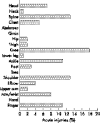Injuries among elite snowboarders (FIS Snowboard World Cup)
- PMID: 16505079
- PMCID: PMC2492000
- DOI: 10.1136/bjsm.2005.021329
Injuries among elite snowboarders (FIS Snowboard World Cup)
Abstract
Background: Although snowboarding is already established as an Olympic sport, it is still a developing sport, with new disciplines, more demanding snow installations, and spectacular tricks. A recent study on subjects at Norwegian national elite level showed that injury risk is high and that injuries among competitive snowboarders differ from those seen in recreational snowboarders, with fewer wrist injuries and more knee and back injuries.
Objective: To describe the incidence and type of injuries among female and male snowboarders at international elite level.
Method: At the last race of the Fédération Internationale de Ski Snowboard World Cup, acute injuries resulting in missed participation and overuse injuries influencing performance, were recorded during a retrospective interview (91% response rate). The registration period was from April 2002 (end of season) until March 2003. Exposure was recorded as the number of runs in all disciplines, and the incidence was calculated as number of injuries per 1000 runs.
Results: The 258 athletes interviewed reported 3193 competition days (n = 46 879 runs) in all disciplines. In total, 135 acute injuries were recorded; 62 (46%) during competition in the official disciplines. Of the 135 acute injuries, the most common injury locations were knee (n = 24; 18%), shoulder (n = 18; 13%), back (n = 17; 13%), and wrist (n = 11; 8%). The overall incidence during competition was 1.3 (95% confidence interval 1.0 to 1.7) injuries per 1000 runs; 2.3 (0.9 to 3.8) for big air (n = 10), 1.9 (1.1 to 2.8) for halfpipe (n = 21), 2.1 (1.2 to 3.0) for snowboard cross (n = 20), 0.6 (0.2 to 1.0) for parallel giant slalom (n = 8), and 0.3 (0.0 to 0.7) for parallel slalom (n = 3). The severity of injuries was graded based on time loss (27% lost >21 days) and score on the Abbreviated Injury Scale (AIS) (38% AIS 1, 61% AIS 2 and 1% AIS 3). There were 122 overuse injuries, 38 (31%) of these to the knee.
Conclusion: The injury risk for big air, snowboard cross, and halfpipe disciplines is high, while that for the snowboard slalom disciplines is lower. The injury pattern is different from recreational athletes, with a greater share of knee injuries and fewer wrist injuries. Compared with national level, the injury risk appears to be lower at World Cup level.
Conflict of interest statement
Competing interests: none
Similar articles
-
Injury rate and injury pattern among elite World Cup snowboarders: a 6-year cohort study.Br J Sports Med. 2014 Jan;48(1):18-22. doi: 10.1136/bjsports-2013-092573. Epub 2013 Oct 4. Br J Sports Med. 2014. PMID: 24096896
-
Injuries among competitive snowboarders at the national elite level.Am J Sports Med. 2005 Mar;33(3):370-7. doi: 10.1177/0363546504268043. Am J Sports Med. 2005. PMID: 15716252
-
Injuries among World Cup ski and snowboard athletes.Scand J Med Sci Sports. 2012 Feb;22(1):58-66. doi: 10.1111/j.1600-0838.2010.01147.x. Epub 2010 Jun 18. Scand J Med Sci Sports. 2012. PMID: 20561277
-
Injuries in elite and recreational snowboarders.Br J Sports Med. 2014 Jan;48(1):11-7. doi: 10.1136/bjsports-2013-093019. Epub 2013 Nov 26. Br J Sports Med. 2014. PMID: 24282020 Review.
-
Winter Sports Injuries in Elite Female Athletes: A Narrative Review.Int J Environ Res Public Health. 2023 May 13;20(10):5815. doi: 10.3390/ijerph20105815. Int J Environ Res Public Health. 2023. PMID: 37239544 Free PMC article. Review.
Cited by
-
An evidence-based review: efficacy of safety helmets in the reduction of head injuries in recreational skiers and snowboarders.J Trauma Acute Care Surg. 2012 Nov;73(5):1340-7. doi: 10.1097/TA.0b013e318270bbca. J Trauma Acute Care Surg. 2012. PMID: 23117389 Free PMC article. Review.
-
Trends in Anterior Cruciate Ligament Injury and Recovery in Professional Snowboarders: The Extreme Sport of Snowboardcross.Cureus. 2023 Dec 17;15(12):e50683. doi: 10.7759/cureus.50683. eCollection 2023 Dec. Cureus. 2023. PMID: 38229820 Free PMC article.
-
Feature-specific terrain park-injury rates and risk factors in snowboarders: a case-control study.Br J Sports Med. 2014 Jan;48(1):23-8. doi: 10.1136/bjsports-2012-091912. Epub 2013 Nov 1. Br J Sports Med. 2014. PMID: 24184587 Free PMC article.
-
A Survey on Current Practices, Needs, Responsibilities and Preferences for Knowledge Dissemination in the Field of Injury and Illness Prevention Among Competitive Snow Sports Stakeholders.Sports Med Open. 2025 Feb 19;11(1):17. doi: 10.1186/s40798-025-00818-9. Sports Med Open. 2025. PMID: 39971816 Free PMC article.
-
Management of injuries in snowboarders: rehabilitation and return to activity.Open Access J Sports Med. 2018 Oct 11;9:221-231. doi: 10.2147/OAJSM.S146716. eCollection 2018. Open Access J Sports Med. 2018. PMID: 30349409 Free PMC article. Review.
References
-
- Torjussen J, Bahr R. Injuries among competitive snowboarders at the national elite level. Am J Sports Med 200533370–377. - PubMed
-
- Dann K, Kristen K H, Boldrino C. Verletzungen von Snowboard‐Profis. Sportothopaedie Sporttraumatologie 19964257–260.
-
- Ekeland A, Dimmen S, Lystad H. Completion rate and injuries in alpine races during the 1994 Olympic Winter Games. Scand J Med Sci Sports 19966287–290. - PubMed
Publication types
MeSH terms
LinkOut - more resources
Full Text Sources
Miscellaneous

